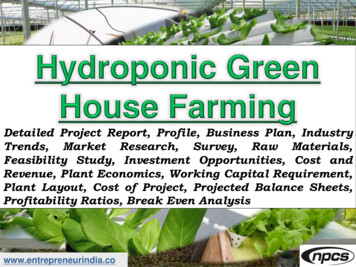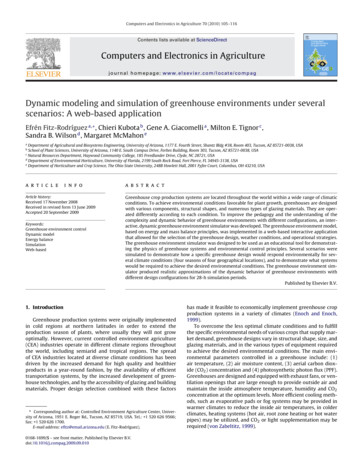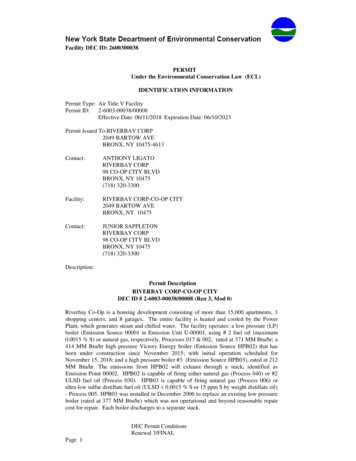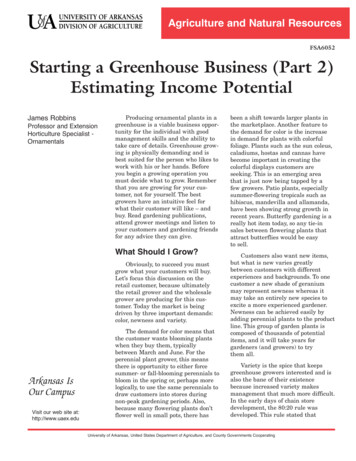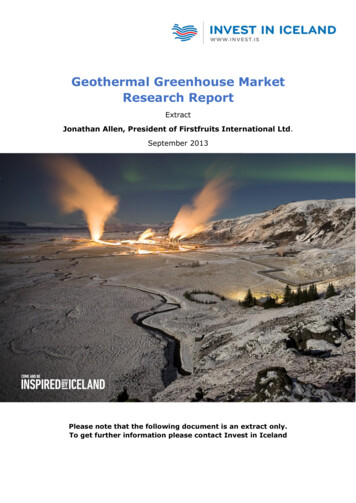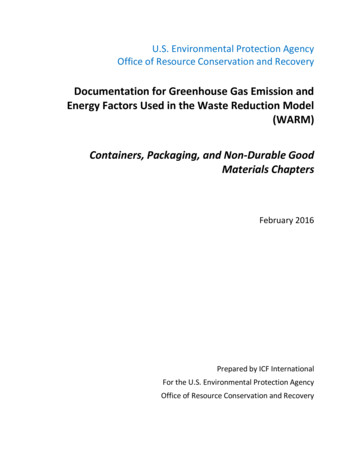
Transcription
U.S. Environmental Protection AgencyOffice of Resource Conservation and RecoveryDocumentation for Greenhouse Gas Emission andEnergy Factors Used in the Waste Reduction Model(WARM)Containers, Packaging, and Non-Durable GoodMaterials ChaptersFebruary 2016Prepared by ICF InternationalFor the U.S. Environmental Protection AgencyOffice of Resource Conservation and Recovery
THIS PAGE IS INTENTIONALLY LEFT BLANK
WARM Version 14Table of ContentsFebruary 2016Table of Contents1Glass . 1-12Metals . 2-13Paper Products . 3-14Polylactide (PLA) Biopolymer . 4-15Plastics. 5-1
WARM Version 141GlassFebruary 2016GLASS1.1 INTRODUCTION TO WARM AND GLASSThis chapter describes the methodology used in EPA’s Waste Reduction Model (WARM) to estimate streamlinedstreamlined life-cycle greenhouse gas (GHG) emission factors for glass, beginning at the point of wastegeneration. The WARM GHG emission factors are used to compare the net emissions associated with glass inglass in the following four materials management alternatives: source reduction, recycling, landfilling, andand combustion.Exhibit 1-1 shows the general outline of materials management pathways for glass in WARM. Forbackground information on the general purpose and function of WARM emission factors, see the WARMBackground & Overview chapter. For more information on Source Reduction, Landfilling, andCombustion, see the chapters devoted to those processes. WARM also allows users to calculate resultsin terms of energy, rather than GHGs. The energy results are calculated using the same methodologydescribed here but with slight adjustments, as explained in the Energy Impacts chapter.Exhibit 1-1: Life Cycle of Glass in WARMWARM assumes that all glass waste is in the form of containers and packaging, including beerand soft drink bottles, wine and liquor bottles, and food and other bottles and jars. The model does notaccount for glass waste that is a component of durable goods such as appliances, furniture andconsumer electronics, or for other types of glass such as the flat or plate glass used in picture frames,mirrors or windows.1-1
WARM Version 14GlassFebruary 2016The recovery and subsequent recycling of glass is considered to be a closed-loop process (i.e.,glass bottles and jars are remanufactured into more glass bottles and jars).1.2 LIFE-CYCLE ASSESSMENT AND EMISSION FACTOR RESULTSThe streamlined life-cycle GHG analysis in WARM focuses on the waste generation point, or themoment a material is discarded, as the reference point and only considers upstream GHG emissionswhen the production of new materials is affected by materials management decisions.1 Recycling andsource reduction are the two materials management options that impact the upstream production ofmaterials, and consequently are the only management options that include upstream GHG emissions.For more information on evaluating upstream emissions, see the chapters on Recycling and SourceReduction.The overall life-cycle energy associated with manufacturing glass from virgin inputs and recycledinputs is shown in Exhibit 1-2.Exhibit 1-2: Process and Transportation Energy for Manufacture of Glass Using Virgin and Recycled InputsMaterialGlassVirgin ManufactureProcess EnergyTransportationper Short TonEnergy per ShortMade fromTon Made fromVirgin InputsVirgin Inputs(Million Btu)(Million Btu)6.490.58Total7.08Recycled ManufactureTransportationProcess Energy perEnergy per ShortShort Ton MadeTon Made fromfrom Recycled InputsRecycled Inputs(Million Btu)(Million Btu)4.320.34Total4.66Source: RTI (2004).As Exhibit 1-3 illustrates, most of the GHG sources relevant to glass in this analysis fall under theraw materials acquisition and manufacturing section of the life-cycle. The recycling and source reductionpathways are most relevant to glass since the upstream emissions associated with glass production aresignificant. Glass does not contain carbon and does not generate CH4 emissions when landfilled.Therefore, the emissions associated with landfilling glass include only transportation- and landfillequipment-related emissions. Glass cannot be composted or anaerobically digested and therefore thesepathways are not considered in WARM.Exhibit 1-3: Glass GHG Sources and Sinks from Relevant Materials Management PathwaysMaterialsManagementStrategies forGlassSource ReductionGHG Sources and Sinks Relevant to GlassRaw Materials Acquisition andManufacturingOffsets Transport of raw materials andproducts Virgin manufacture processenergy Virgin manufacture process nonenergyChanges in Forest or SoilCarbon StorageNA1End of LifeNAThe analysis is streamlined in the sense that it examines GHG emissions only and is not a comprehensiveenvironmental analysis of all environmental impacts from municipal solid waste management options.1-2
WARM Version 14MaterialsManagementStrategies assFebruary 2016GHG Sources and Sinks Relevant to GlassRaw Materials Acquisition andChanges in Forest or SoilManufacturingCarbon StorageEnd of LifeEmissionsNAEmissions Transport of recycled materials Collection and transportation torecycling center Recycled manufacture processenergy Sorting and processing energy Recycled manufacture processnon-energyOffsets Transport of raw materials andproducts Virgin manufacture processenergy Virgin manufacture process nonenergyNot applicable since glass cannot be compostedNANAEmissions Transport to WTE facility Energy required for combustionNANAEmissions Transport to landfill Landfilling machineryAnaerobicDigestionNot applicable since glass cannot be anaerobically digestedNA Not applicable.WARM analyzes all of the GHG sources and sinks outlined in Exhibit 1-3 and calculates net GHGemissions per short ton of glass generated for each materials management alternative as shown inExhibit 1-4. For additional discussion on the detailed methodology used to develop these emissionfactors, see sections 1.3 and 1.4.Exhibit 1-4: Net Emissions for Glass under Each Materials Management Option (MTCO 2E/Short Ton)MaterialGlassNet SourceReduction (Reuse)GHG Emissions ForCurrent Mix ofInputs-0.53Net RecyclingGHGEmissions-0.28NetCompostingGHG EmissionsNANetCombustionGHG Emissions0.03Net LandfillingGHGEmissions0.02Net AnaerobicDigestionEmissionsNANote: Negative values denote net GHG emission reductions or carbon storage from a materials management practice.NA This materials management option is not applicable to this material.1.3 RAW MATERIALS ACQUISITION AND MANUFACTURINGFor glass, the GHG emissions associated with raw materials acquisition and manufacturing(RMAM) are (1) GHG emissions from energy used during the acquisition and manufacturing processes,(2) GHG emissions from energy used to transport materials, and (3) non-energy GHG emissions resultingfrom manufacturing processes. Process non-energy GHG emissions occur during the manufacture ofcertain materials and are not associated with energy consumption.The typical composition of container glass is shown in Exhibit 1-5. The first step in glassmanufacture is mining, transporting and processing the minerals that will be the glass inputs. Themining, transportation and processing steps use energy and emit energy-related GHGs. Once the glassinputs are transported to the glass manufacturing facility, the main processes in glass manufacture arebatch preparation, melting and refining, forming and post forming (DOE, 2002).1-3
WARM Version 14GlassFebruary 2016Batch preparation. Varied quantities of raw ingredients are blended together, based on thetype of glass being manufactured. Glass inputs must include: formers, the main component of the glass;fluxes, which lower the temperature at which the glass melts; and stabilizers, which make the glass morechemically stable and increase the strength of the finished product. The typical composition ofcontainer glass is shown in Exhibit 1-5; other ingredients such as colorants may be added. Thismanufacturing stage consumes fossil fuels used for energy production, resulting in energy-related GHGemissions (DOE, 2002).Exhibit 1-5: Typical Composition of Modern Container GlassChemicalSilica (SiO2)Soda (Na2O)Potash (K2O)Lime (CaO)Magnesia (MgO)Alumina abilizerSourceSandSoda ash (Na2CO3) from trona oreMined and processed potassium saltsLimestone (CaCO3)Impurity in limestoneFeldspar% Composition72% to 73.5%12% to 14%0.6%9% to 12%1.2% to 2.0%1.2% to 2.0%Source: DOE (2002).Melting and refining. The glass is melted in a furnace to the correct temperature, and bubblesand other inclusions are removed. This manufacturing stage results in both energy emissions and nonenergy process CO2 emissions from the heating of carbonates (soda ash and limestone) (DOE, 2002).Forming. The molten glass is formed into its final shape. The glass can be molded, drawn, rolled,cast, blown, pressed or spun into fibers. Commercial glass containers are formed using molds. Thismanufacturing stage consumes fossil fuels used for energy production, resulting in energy-related GHGemissions (DOE, 2002).Post-Forming. Various processes may be applied to the formed glass, depending on the resultsdesired, including curing, annealing, tempering, coating and cutting. Container glass is annealed andusually coated with scratch-resistant coatings consisting of a thin layer of tin or titanium oxide followedby a lubricant such as polyethylene. This manufacturing stage uses energy and results in energy-relatedGHG emissions (DOE, 2002).The RMAM calculation in WARM also incorporates “retail transportation,” which consists of theaverage truck, rail, water and other-modes transportation emissions required to get the glass from themanufacturing facility to the retail/distribution point. The energy and GHG emissions from retailtransportation are presented in Exhibit 1-6, and are calculated using data on average shipping distancesand modes from the U.S. Bureau of Transportation Statistics (BTS, 2013) and on typical transportationfuel efficiencies from EPA (1998). Transportation emissions from the retail point to the consumer arenot included.Exhibit 1-6: Retail Transportation Energy Use and GHG EmissionsMaterialGlassAverage Miles per Shipment356Retail Transportation Energy(Million Btu per Short Ton ofProduct)0.39Retail TransportationEmissions (MTCO2E perShort Ton of Product)0.03The total RMAM emissions for glass manufacturing are shown in the section on sourcereduction. The net emission factors for source reduction and recycling of glass include RMAM“upstream” emissions.1-4
WARM Version 14GlassFebruary 20161.4 MATERIALS MANAGEMENT METHODOLOGIESThis analysis considers source reduction, recycling, landfilling and combustion pathways formaterials management of glass. For glass, source reduction and recycling result in net negativeemissions (i.e., a net reduction in GHG emissions), while combustion and landfilling result in slightlypositive net emissions.Glass is rarely manufactured from 100 percent virgin inputs or 100 percent recycled inputs.Exhibit 1-7 shows the range of recycled content used for manufacturing glass. Therefore “virgin” glassas referred to in the rest of this chapter is assumed to contain 5 percent recycled inputs.Exhibit 1-7: Typical Glass Recycled Content Values in the MarketplaceMaterialRecycled Content MinimumGlassRecycled Content Maximum5%30%Glass is most frequently manufactured using “virgin” inputs, or a very low percentage ofrecycled inputs. However, it is also manufactured using higher amounts of recycled inputs than in“virgin” production. The current mix of production from recycled and “virgin” inputs used formanufacturing glass is shown in Exhibit 1-8.Exhibit 1-8: Current Mix of Production from Virgin and Recycled Inputs for Glass ManufacturingProductGlass% of Current Production fromRecycled Inputs23%% of Current Production from "Virgin"Inputs77%Note: Rounded to nearest percentage.The emission factors for source reduction and recycling are affected by the mix of inputs usedfor the manufacturing process. The emission factor for glass produced from the current mix of virgin andrecycled inputs is calculated using a weighted average of virgin and recycled glass production data,based on the values in Exhibit 1-8. WARM also calculates an emission factor for producing glass from“virgin” inputs, assuming a recycled content of 5 percent (the industry minimum recycled content). GHGimplications and emission factors for glass in each pathway are discussed in sections 4.1 through 4.5.1.4.1Source ReductionWhen a material is source reduced, GHG emissions associated with making the material andmanaging the post-consumer waste are avoided. As discussed previously, under the measurementconvention used in this analysis, source reduction for glass has negative raw material and manufacturingGHG emissions (i.e., it avoids baseline emissions attributable to current production) and zero materialsmanagement GHG emissions. For more information, please refer to the module on Source Reduction.Exhibit 1-9 outlines the GHG emission factor for source reducing glass. GHG benefits of sourcereduction are calculated as the emissions savings from avoided raw materials acquisition andmanufacturing (see section 3) of glass produced from a “current mix” of virgin and recycled inputs orfrom glass produced from “100-percent virgin” inputs.22The “100 percent virgin” inputs emission factor assumes a minimum recycled content of 5 percent, since glass israrely manufactured from entirely virgin inputs.1-5
WARM Version 14GlassFebruary 2016Exhibit 1-9: Source Reduction Emission Factors for Glass (MTCO2E/Short Ton)MaterialGlassRaw MaterialAcquisition andManufacturingfor Current Mixof Inputs-0.53Raw MaterialAcquisition andManufacturingfor 100% VirginInputs-0.60Forest CarbonStorage forCurrent Mix ofInputsNAForest CarbonStorage for100% VirginInputsNANet Emissionsfor Current Mixof Inputs-0.53NetEmissionsfor 100%VirginInputs-0.60NA Not applicable.Post-consumer emissions are the emissions associated with materials management pathwaysthat could occur at end of life. When source reducing glass, there are no post-consumer emissionsbecause production of the material is avoided in the first place, and the avoided glass never becomespost-consumer. Forest carbon storage is not applicable to glass, and thus does not contribute to thesource reduction emission factor.1.4.1.1Developing the Emission Factor for Source Reduction of GlassTo produce glass, substantial amounts of energy are used both in the acquisition of rawmaterials and in the manufacturing process itself. In general, the majority of energy used for theseactivities is derived from fossil fuels. Combustion of fossil fuels results in emissions of CO2. In addition,manufacturing glass also results in process non-energy CO2 emissions from the heating of carbonates(soda ash and limestone). Hence, the RMAM component consists of process energy, non-process energyand transport emissions in the acquisition and manufacturing of raw materials, as shown in Exhibit 1-10.Exhibit 1-10: Raw Material Acquisition and Manufacturing Emission Factor for Virgin Production of Glass(MTCO2E/Short Ton)(a)(b)MaterialGlass(c)Process Energy0.37Transportation Energy0.07(d)Process Non-Energy0.16(e)Net Emissions(e b c d)0.60Source: RTI (2004).To calculate this factor, EPA obtained an estimate of the amount of energy required to acquireand produce one short ton of glass, which is reported as 6.49 million Btu (RTI, 2004). Next, wedetermined the fuel mix that comprises this Btu estimate (RTI, 2004) and then multiplied the fuelconsumption (in Btu) by the fuel-specific carbon content. The sum of the resulting GHG emissions byfuel type comprises the total process energy GHG emissions, including both CO2 and CH4, from all fueltypes used in glass production. The process energy used to produce glass and the resulting emissions areshown in Exhibit 1-11.Exhibit 1-11: Process Energy GHG Emissions Calculations for Virgin Production of GlassMaterialGlassProcess Energy per Short Ton Madefrom Virgin Inputs (Million Btu)6.49Process Energy GHG Emissions(MTCO2E/Short Ton)0.37Source: RTI (2004).Transportation energy emissions occur when fossil fuels are used to transport raw materials andintermediate products for glass production. The methodology for estimating these emissions is the sameas the one used for process energy emissions. Based on estimated total glass transportation energy (RTI,2004), EPA calculates the total emissions using fuel-specific carbon coefficients. The calculations forestimating the transportation energy emission factor for glass are shown in Exhibit 1-12.1-6
WARM Version 14GlassFebruary 2016Exhibit 1-12: Transportation Energy Emissions Calculations for Virgin Production of GlassTransportation Energy per Short TonMade from Virgin Inputs (Million Btu)MaterialGlassTransportation Energy GHG Emissions(MTCO2E/Short Ton)0.580.04Note: The transportation energy and emissions in this exhibit do not include retail transportation, which is presented separately in Exhibit 1-6.Non-energy GHG emissions occur during manufacturing but are not related to consuming fuelfor energy. For glass, non-energy CO2 emissions (based on data from ICF (1994)) are emitted in thevirgin glass manufacturing process during the melting and refining stages from the heating of carbonates(soda ash and limestone). Exhibit 1-13 shows the components for estimating process non-energy GHGemissions for glass.Exhibit 1-13: Process Non-Energy Emissions Calculations for Virgin Production of sions(MT/ShortTon)0.16CF4 )–Non-EnergyCarbonEmissions(MTCO2E/ShortTon )N2OEmissions(MT/ShortTon)––0.16– Zero emissions.1.4.2RecyclingWhen a material is recycled, it is used in place of virgin inputs in the manufacturing process,rather than being disposed of and managed as waste. According to EPA, 34 percent of glass containersand packaging in the U.S. municipal solid waste stream are recycled each year (EPA, 2015). Glass, likemost of the materials in WARM, is modeled as being recycled in a closed loop. This section describes thedevelopment of the recycling emission factor for glass, which is shown in the final column of Exhibit1-14. For more information, please refer to the Recycling chapter.Exhibit 1-14: Recycling Emission Factor for Glass (MTCO2E/Short Ton)MaterialGlassRaw MaterialAcquisitionandManufacturing(Current Mixof nputCreditaProcessEnergy-0.12Recycled InputCredita –TransportationEnergy-0.02RecycledInputCredita –ProcessNonEnergy-0.14Forest e: Negative values denote net GHG emission reductions or carbon storage from a materials management practice.a Includes emissions from the initial production of the material being managed.1.4.2.1Developing the Emission Factor for the Recycling of GlassEPA calculates the GHG benefits of recycling glass by comparing the difference between theemissions associated with manufacturing a short ton of glass from recycled materials and the emissionsfrom manufacturing the same ton from virgin materials, after accounting for losses that occur in therecycling process. This difference is called the “recycled input credit” and represents the net change inGHG emissions from process energy, transportation energy and process non-energy sources in recyclingglass relative to virgin production of glass.To calculate each component of the recycling emission factor, EPA follows six steps, which aredescribed in detail below.1-7
WARM Version 14GlassFebruary 2016Step 1. Calculate emissions from virgin production of one short ton of glass. We apply fuelspecific carbon coefficients to the process and transportation energy use data for virgin RMAM of glass(RTI, 2004). This estimate is then summed with the emissions process non-energy emissions (ICF, 1994)to calculate the total emissions from virgin production of glass. The calculations for virgin process,transportation and process non-energy emissions for glass are presented in Exhibit 1-11, Exhibit 1-12,and Exhibit 1-13, respectively.Step 2. Calculate GHG emissions for recycled production of glass. WARM applies the same fuelspecific carbon coefficients to the process and transportation energy use data from RTI (2004) for theproduction of recycled glass, as shown in Exhibit 1-15 and Exhibit 1-16. There were no process nonenergy emissions from recycled production of glass. These sources are summed to calculate the totalemissions from the production of recycled glass.Exhibit 1-15: Process Energy GHG Emissions Calculations for Recycled Production of GlassMaterialGlassProcess Energy per Short Ton Madefrom Recycled Inputs (Million Btu)4.32Energy Emissions (MTCO2E/ShortTon)0.23Exhibit 1-16: Transportation Energy GHG Emissions Calculations for Recycled Production of GlassTransportation Energy per Ton MadeTransportation Emissionsfrom Recycled Inputs (Million Btu)(MTCO2E/Short Ton)Glass0.340.02Note: The transportation energy and emissions in this exhibit do not include retail transportation, which is presented separatelyin Exhibit 1-6.MaterialStep 3. Calculate the difference in emissions between virgin and recycled production. Tocalculate the GHG emissions savings from recycling one short ton of glass, WARM subtracts the recycledproduct emissions (calculated in Step 2) from the virgin product emissions (calculated in Step 1) to getthe GHG savings. These results are shown in Exhibit 1-17.Exhibit 1-17: Differences in Emissions between Recycled and Virgin Glass Manufacture (MTCO 2E/Short Ton)MaterialGlassProduct Manufacture Using100% Virgin Inputs(MTCO2E/Short rgy0.370.070.16Product Manufacture Using100% Recycled Inputs(MTCO2E/Short rgy0.230.05–Difference Between Recycled andVirgin Manufacture(MTCO2E/Short rgy-0.14-0.02-0.16Step 4. Adjust the emissions differences to account for recycling losses. Material losses occur inboth the recovery and manufacturing stages of recycling. The loss rate represents the percentage ofend-of-life glass collected for recycling that is lost during the recovery or remanufacturing process, andultimately disposed of. WARM applies a 2.4 percent loss rate for glass (FAL, 2003; RTI, 2004). Thedifferences in emissions from virgin versus recycled process energy, transportation energy and nonenergy processing are adjusted to account for the loss rates by multiplying the final three columns ofExhibit 1-17 by 97.6 percent, the amount of material retained after losses (i.e., 100 percent input – 2.4percent lost 97.6 percent retained).1.4.3CompostingGlass is not subject to aerobic bacterial degradation, and therefore, cannot be composted.Consequently, WARM does not include composting as an end-of-life pathway for glass.1-8
WARM Version 14GlassFebruary 20161.4.4CombustionWARM estimates (1) gross emissions of CO2 and N2O from MSW combustion (includingemissions from transportation of waste to the combustor and ash from the combustor to a landfill) and(2) CO2 emissions avoided due to displaced electric utility generation. WARM subtracts GHG emissionsavoided from energy recovery from direct combustion GHG emissions to obtain an estimate of the netGHG emissions from MSW.Glass, however, cannot be combusted, and instead absorbs a small amount of heat during MSWcombustion that could otherwise be recovered and used to produce electricity. Consequently, Exhibit1-18 shows that the emission factor for combusting glass includes transportation to the facility and asmall increase in utility emissions for power generation that would otherwise have been avoided if theglass were not sent to the combustor.Exhibit 1-18: Components of the Combustion Net Emission Factor for Glass (MTCO 2E/Short Ton)MaterialGlassRaw MaterialAcquisition andManufacturing(Current Mix ofInputs)–Transportationto Combustion0.01CO2 fromCombustion–N20 ecovery–NetEmissions(PostConsumer)0.03– Zero emissions.1.4.4.1Developing the Emission Factor for Combustion of GlassRaw Material Acquisition and Manufacturing: Since WARM takes a materials-managementperspective (i.e., starting at end-of-life disposal of a material), RMAM emissions are not included for thismaterials management pathway.Transportation to Combustion: GHG emissions from transportation energy use were estimatedto be 0.01 MTCO2E for one short ton of glass (FAL, 1994).CO2 from Combustion and N2O from Combustion: Glass does not contain any C or N, so theemission factors for CO2 and N2O from combustion are estimated to equal zero.3Avoided Utility Emissions: Most waste-to-energy (WTE) plants in the United States produceelectricity. Only a few cogenerate electricity and steam. In this analysis, EPA assumed that the energyrecovered with MSW combustion would be in the form of electricity, and thus estimated the avoidedelectric utility CO2 emissions associated with combustion of waste in a WTE plant. Avoided utilityemissions for glass, however, are positive. This means that, instead of being avoided, emissions increaseslightly due to the presence of glass in MSW at combustion facilities. EPA developed these estimatesfrom data on the specific heat of glass (Incropera and DeWitt, 1990), and calculated the energy requiredto raise the temperature of glass from ambient temperature to the temperature found in a combustor(about 750 Celsius). Therefore, the amount of energy absorbed by one ton of glass in an MSWcombustor would have resulted in less than 0.02 MTCO2E of avoided utility CO2, if the glass had not beensent to the combustor,.Steel Recovery: There are no steel recovery emissions associated with glass because it does notcontain steel.3At the relatively low combustion temperatures found in MSW combustors, most of the nitrogen in N2O emissionsis derived from the waste, not from the combustion air. Because glass does not contain nitrogen, EPA concludedthat running these materials through an MSW combustor would not result in N 2O emissions.1-9
WARM Version 14GlassFebruary 2016Because transportation and avoided utility emissions are positive emission factors, net GHGemissions for combustion are positive for glass.1.4.5LandfillingWARM considers the CH4 emissions, transportation-related CO2 emissions and carbon storagethat will result from landfilling each type of organic waste and mixed MSW. Because glass is not anorganic material, it does not generate CH4 or sequester any carbon when landfilled. The only emissionsassociated with landfilling glass are those from transporting glass to the landfills and moving wastearound in the landfills. Transportation of waste materials results in anthropogenic CO2 emissions due tothe combustion of fossil fuels in the vehicles used to haul the wastes. For further information, pleaserefer to the chapter on Landfilling. Exhibit 1-19 provides the net emission factor for landfilling glass.Exhibit 1-19: Landfilling Emission Factor for Glass (MTCO2E/Short Ton)MaterialGlassRaw MaterialAcquisition andManufacturing(Current Mix ofInputs)–Transportationto Landfill0.02LandfillCH4–Avoided CO2Emissions fromEnergy Recovery–Landfill CarbonStorage–Net Emissions(PostConsumer)0.02– Zero emissions.1.4.6Anaerobic DigestionBecause of the nature of glass components, glass cannot be anaerobically digested, and thus,WARM does not include an emission factor for the anaerobic digestion of glass.1.5 LIMITATIONSEPA did not consider glass contained in durable goods as part of this analysis due to the lack ofrelevant data.1.6 REFERENCESBTS. (2013). Commodity Flow Survey Preliminary Tables. Table 1: Shipment Characteristics by Mode ofTransportation for the United States: 2012. Washington, DC: U.S. Bureau of TransportationStatistics, Research and Innovative Technology Administration. Retrieved .bts/files/publications/commodity flow survey/2012/united states/table1.html.DOE. (2002). Energy and Environmental Profile of the U.S. Glass Industry. Washington, DC: U.S.Department of Energy, Office of Industrial Technologies. April.EPA. (2015). Advancing Sustainable Materials Management: Facts and Figures 2013. (EPA530-R-15-002).Washington, DC: U.S. Government Printing Office. Retrieved nment/eCycle/2013 advncng smm rpt.pdf.EPA. (1998). Greenhouse Gas Emissions from the Management of Selected Materials. (EPA publicationno. EPA530-R-98-013.) Washington, DC: U.S. Environmental Protection Agency, Municipal andIndustrial Solid Waste Division.FAL. (2003). Loss rates provided by in-house data from Franklin Associates, Ltd., Prairie Village, KS.1-10
WARM Version 14GlassFebruary 2016FAL. (1994). The Role of Recycling in Integrated Solid Waste Management to the Year 2000. FranklinAssociates, Ltd. (Stamford, CT: Keep America Beautiful, Inc.), September, pp. I-24.ICF. (1994). Memorandum: “Detailed Analysis of Greenhouse Gas Emissions Reductions from IncreasedRecycling and Source Reduction of Municipal Solid Waste,” July 29. Page 48 of
WARM Version 14 Glass February 2016 1-1 1 GLASS 1.1 INTRODUCTION TO WARM AND GLASS This chapter describes the methodology used in EPA’s Waste Reduction Model (WARM) to estimate streamlined streamlined life-cycle greenhouse gas (GHG) em

